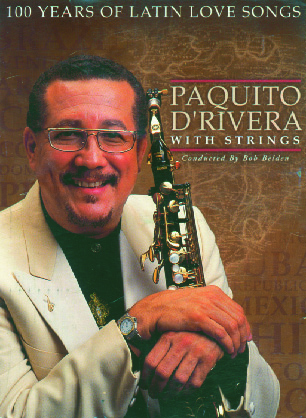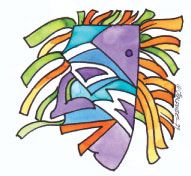CARNIVAL ’99
International Chantuelle
David Rudder (Lypsoland CR 029)
International Chantuelle is a mirror of Trinidad: the sacred and profane, the spirituality and the reality of a complex nation which becomes Adrenalin City during Carnival. Once again, David Rudder, the griot or storyteller, offers the people of Trinidad and Tobago a glimpse of their radiance, and a peek at their pain. If Rudder’s 1998 Carnival album Beloved was a sprinkle of holy water on the head, then this year’s album is a cleansing plunge into the sacred rivers. Carrying the theme of a troubled land’s underlying spirituality to a fresh, new level, Rudder offers eight new songs and a remake of Brigo’s Limbo Dance. One of the best-loved songs on the CD, The Ganges and the Nile (Part I and II), uses the metaphor of the two rivers to represent the two major ethnic groups of Trinidad and Tobago. Rudder reminds his followers of their love and beauty as well as the fact that they’ve always been ahead of the “smart men” and politicians who seek to divide them. The music shows Rudder’s gift for jazzy blues as well as his indelible stamp on soca. Musicians on this album include Barry Howard on drums, Tony Voisin on guitar and Curtis Lewis on saxophone. (DJ)
Caribbean Party Rhythms 4
Various Artists (Rituals)
This CD is a virtual history of the modern rapso movement from its founder Brother Resistance to the present stars 3 Canal with one of Trinidad 1999 Carnival’s biggest hits, Talk Yuh Talk. The 16 tracks include a wide range of rap, reggae and dub-influenced rapso and soca music, with lots of percussion and peppy music which evoke the spirit of J’Ouvert and Carnival. Traditional horns are used to enhance the rhythm. David Rudder’s soulful soca remake of the Bob Marley hit Stir It Up, originally commissioned by EMI records, appears courtesy Polygram records. Arrow’s sizzling hit Hot Hot Hot has been remade by many artists and now Nasty adds his Jamaican rap/Trinidad soca version to the collection. Included is a musical insert of Rose’s Fire Fire in your Wire Wire. Nasty succeeds in giving Arrow’s hit a fresh, new interpretation. Some of the tracks included follow this trend while others are pure mimicry. For the most part, Caribbean Party Rhythms 4 appeals to the new generation, demonstrating that effective rhythm has always formed the root of calypso and soca. (DJ)
The Best Of The Shadow
Shadow (Crossroads Records)
Shadow reaches back into soca’s glorious past and offers re-recordings of nostalgic hits which defined the early stages of calypso’s soulful transition to soca. With numbers such as Bassman, Janette, Pandora, I Come Out To Play and I Come Out To Party, Shadow reminds soca lovers of their beloved musical roots. He also includes his 1999 Carnival hits The Soca Boat, Stop the Boat and Don’t Call Me Alien. Shadow continues to experiment with rhythm. His lyrics, always noted for his wry sense of humour, are unmatched in the business. The 12 tracks on this CD remind soca music lovers of Shadow’s undeniable influence on soca and mark Shadow’s leap into parang soca with Christmas Nice. (DJ)
In Full Bloom
Square One (RaGaCha Music Inc.)
While this primarily party CD runs along the same lines of past Square One albums, there are a few new twists. Songs like That’s The Way I Like It, a sensual remake of this once-popular song, is one example. And there are a few other “oldies” on this 18-cut release, including Vintage Reggae, a medley of three legendary hits, along with a nice spin on the mid-70s Lord Nelson calypso mega-hit, La La. But the tune that is making this CD “pop” is Faluma, an African-sounding uptempo song that has been sweeping the parties across the region. Singing in a Surinamese dialect Alison Hinds demonstrates both her linguistic versatility and her powerful singing talent. Another current hit is Kitty Cat, a soca tune penned and sung by lead singer Andy Armstrong. Personal favourites include the Terry Arthur tune, Gimme What Ya Got, which has Alison singing a slower, more sultry-style soca. Another enticing pick is the purist calypso, Do A Number, which features veteran Barbadian calypsonian Grynner. This is a fun song with lots of character. Many of the songs were written by band members, including the two male lead singers, Andy Armstrong and Cecil Riley, as well as pan/percussionist and song-writer-to-watch, Terry Arthur. (RK)
RAPSO
Atamorphosis
Ataklan (Taj 001CD)
Here’s an artist who is breathing new energy into Trinidad and Tobago’s rapso music, a genre often more earnest than compelling. The 16 tracks (plus four laconic “interludes”) on this CD show that Ataklan (Mark Jiminez) has a lot going for him: a melodic gift which recalls Andre Tanker, and a poetic gift that recalls David Rudder. You could hardly ask for more. Already, his music is showing some of that strange alchemy that marks the best of Caribbean song-writing: music you want to dance to, but which at the same time carries the sort of conscious message that makes you think and feel. His music is meditation in celebration, with strong melodies, thoughtful lyrics, a Caribbean-wide musical palette, some unexpected humour and a welcome innocence. This music goes far beyond the wine-and-jam syndrome. Whether he’s dreaming of his own “piece of mountain”, blasting the race-merchants, satirising male deceit or simply celebrating the spirit, there’s promise in every line. (JT)
PAN
Feelin’ Good
Panazz (BBLN 1998)
Panazz is an object lesson in how small is beautiful. This ten-member Trinidad and Tobago group — pans plus percussion — has graduated from the competition culture in which most pan ensembles are stuck, to become a professional performing unit. It has left behind the 100-player musical mammoths to develop a fluent, sophisticated style that can range from calypso through jazz to contemporary hits. The playing is as musical as you’ll find in a tradition where raw talent is more familiar than subtlety: these are players who don’t beat all the ugly harmonics out of their instruments, who can ramajay with style and humour, who don’t play sempre fortissimo, and who care about good tuning. After their first two albums, which established a solid reputation, the players are joined on Feelin’ Good by Barbadian sax player Arturo Tappin, Ralph Davies (keyboards) and Stanley Ruiz on guitar. The 11 tracks do not feature much Caribbean material — only two stylish Kitchener numbers (Pan Of The 21st Century and Ole Lady Walk A Mile), which will disappoint some Panazz fans. The rest are jazz standards (Cheek To Cheek, I’ll Remember April), plus James Brown, Gypsy Kings and Stevie Wonder. Nice versions of well-travelled tunes — but there’s so much Caribbean material crying out for the Panazz treatment. (JT)
LATIN
100 Years Of Latin Love Songs
Paquito d’Rivera (Heads Up HUCD3045)
A whole century of Latin love? It could be too much of a good thing. But it works. Paquito d’Rivera in languid mood, backed by lush strings and a band that includes cuatro and Paraguayan harp, revives some of the greatest melodies from across South America and the Spanish Caribbean, and gives them an irresistibly low-key and romantic treatment. The closeness of Latin and Caribbean traditions is striking: listening to Tu Maripos from 1920s Colombia, you could swear you were in Martinique. This 10-track “enhanced “ CD comes from the same label that produces the Caribbean Jazz Project releases, on which Paquito features with Andy Narell and Dave Samuels: and it includes well-presented and genuinely informative liner notes — something Caribbean labels tend to neglect. The music ranges from 1905 Argentina (La Morocha) to the global 1998 hit Corazón Partio; it takes one song for each decade, wandering through Chile, Brazil, Colombia and Venezuela to Cuba, Puerto Rico and the Dominican Republic. Good for anyone who likes Paquito’s clarinet or who can remember what romance is. (JT)
Folk
A Caribbean Sampler; Carriacou Calaloo; East Indian Music in the West Indies
(Rounder Records 11661-1721-2, 11661-1722-2, 11661-1723-2)
With these three CDs (A Caribbean Sampler, Carriacou Calaloo and East Indian Music in the West Indies) Rounder Records has documented and preserved several hundred years of priceless Caribbean music and culture. For anyone who has ever wondered about the origins of Calypso, Zouk and Kadans, or been moved by the chants of the Baptists; listened to the game songs of children across the region or the complex threads of Europe, Africa and Asia which continue to be heard daily in the islands; the Caribbean Voyage series is a gift from the Gods, all of them. Ayi Boo! This project has been in process since 1962, when American ethnographer Alan Lomax set out to make a systematic study of Caribbean music, concentrating on the smaller islands of the Lesser Antilles. His study and field recordings were undertaken in a climate of anticipated West Indian federation and he was helped in his research by the University of the West Indies.
The Federation was short-lived and despite Lomax’s efforts to put his recordings on disc, it is only now that the world can listen to these extraordinary voices and songs from the past. Thankfully, it is still possible to hear much of this music still being played in villages and rural communities throughout the islands.
What emerges is both diversity and unity which led Lomax himself to comment “Having looked at the music of the whole world, no small area is more tightly knit in its musical culture than the Antilles.” Besides forms like the bele, kalinda and quadrille, which can still be found from Cuba to Curaçao, the Caribbean Voyage offers such extremes as a medieval French ballad from St Barts, a Dahomean song from Carriacou and music from a Guadeloupean Kali ceremony. Superbly re-mastered, this collection also allows us to overhear snatches of conversation between Lomax and participating musicians amid the feast of musics. (SL)






















